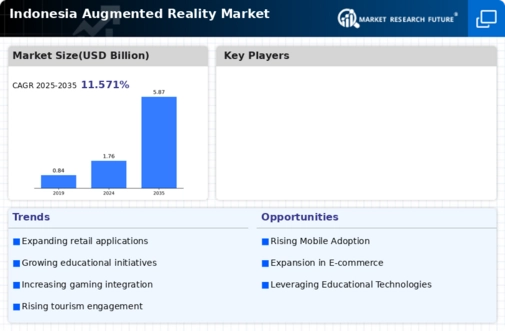Advancements in Mobile Technology
The rapid advancements in mobile technology are significantly influencing the augmented reality market in Indonesia. With the proliferation of smartphones equipped with advanced cameras and sensors, the accessibility of AR applications has increased dramatically. As of November 2025, it is estimated that over 70% of the population owns a smartphone, providing a substantial user base for AR applications. This widespread adoption is likely to drive the development of new AR solutions tailored for mobile devices, enhancing user experiences in gaming, education, and tourism. The integration of AR features into popular mobile platforms further indicates a promising trajectory for the augmented reality market, as developers seek to capitalize on the growing mobile user demographic.
Supportive Government Initiatives
The Indonesian government is actively promoting the adoption of augmented reality technologies through various initiatives aimed at fostering innovation and digital transformation. Policies encouraging investment in technology and digital infrastructure are likely to create a conducive environment for the growth of the augmented reality market. For example, government-backed programs aimed at enhancing digital literacy and supporting tech startups are expected to stimulate the development of AR applications across different sectors. This support may lead to increased collaboration between public and private entities, further propelling the augmented reality market forward. As a result, the market could witness a compound annual growth rate (CAGR) of around 25% over the next few years, driven by these initiatives.
Growing Demand for Interactive Experiences
The augmented reality market in Indonesia is experiencing a notable surge in demand for interactive experiences across various sectors. This trend is particularly evident in retail, where businesses are increasingly adopting AR solutions to enhance customer engagement. For instance, AR applications allow consumers to visualize products in their own environment before making a purchase, thereby improving decision-making. According to recent data, the retail sector's investment in AR technologies is projected to grow by approximately 30% annually, indicating a robust appetite for innovative shopping experiences. Furthermore, the entertainment industry is also leveraging AR to create immersive experiences, suggesting that the augmented reality market is becoming integral to consumer interactions in Indonesia.
Emergence of Local Startups and Innovation Hubs
Local startups and innovation hubs are emerging in Indonesia, playing a crucial role in shaping the augmented reality market. These startups are developing unique AR applications tailored to local needs, which may enhance the overall market landscape. The presence of innovation hubs fosters collaboration among tech enthusiasts, entrepreneurs, and investors, creating a vibrant ecosystem for AR development. As of November 2025, it is estimated that the number of AR-focused startups in Indonesia has increased by over 40% in the past year, indicating a robust entrepreneurial spirit. This influx of local talent and creativity is likely to drive innovation in the augmented reality market, leading to the introduction of diverse applications across various industries.
Rising Interest in Education and Training Solutions
The augmented reality market in Indonesia is witnessing a growing interest in educational and training solutions that leverage AR technology. Educational institutions are increasingly adopting AR tools to create immersive learning experiences, which can enhance student engagement and retention. For instance, AR applications that allow students to visualize complex concepts in 3D are becoming more prevalent in classrooms. Additionally, the corporate sector is utilizing AR for training purposes, enabling employees to practice skills in a simulated environment. This trend is likely to contribute to a significant increase in the adoption of AR technologies in educational settings, with projections suggesting a growth rate of approximately 20% in this segment of the market.











Leave a Comment